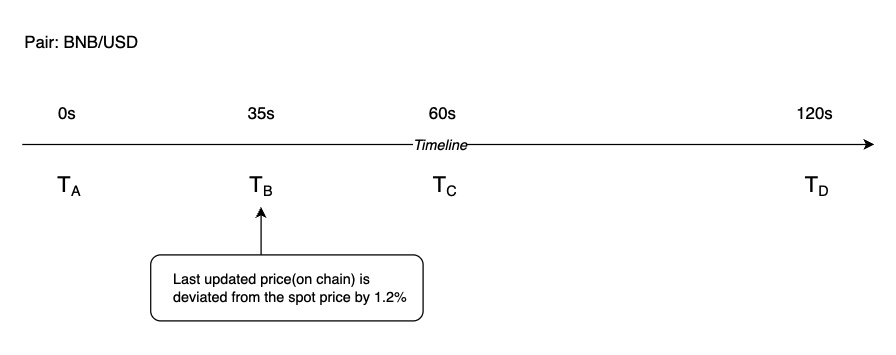Refresh Frequency
About refresh frequency
Data timeliness and accuracy is of the utmost importance in Binance Oracle. To ensure accurate data are fed to the smart contracts in a timely manner, Binance Oracle will feed the price to the smart contracts in regard to two dimensions, price and time.
Price
A blockchain oracle is not going to feed the data to the on-chain smart contracts in a real time manner. Every transaction on-chain is going to incur a gas fee. To balance the data timeliness and the well spent of the gas fee, the price will only be fed when there is a significant change.
In Binance Oracle, we evaluate the asset pair in a case by case manner. For each asset pair, there will be a deviation threshold being assigned to it. Whenever the price deviation is compared to the last update crosses the threshold, a new update will be triggered.
Time
Very often, the price of a particular asset may stay within a certain price range, so that the price deviation doesn't cross the threshold. Binance Oracle will still feed the price to the on-chain smart contracts from time to time, to ensure that users are not getting a stale price. The longest time period that the Binance Oracle will feed the price is called heartbeat. It is a signal to the users that the service is still up and running healthily.
These two parameters are meticulously configured to ensure data timeliness and accuracy.
Example

Referring to the Feeds available page, the deviation threshold and heartbeat of BNB/USD are 1% and 60s.
For example, the price on-chain differed from the latest price by 1.2% at TB, which exceeds the assigned deviation threshold by 0.2%. Therefore, the update condition is met and triggers an on-chain oracle price update.
As BNB/USD's heartbeat is 60s, it will be updated at TA, TC and TD and you may notice that all of them are separated by a 60s time interval.